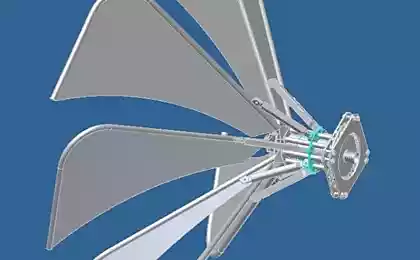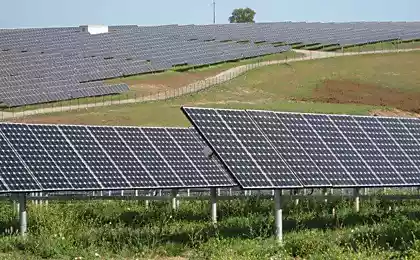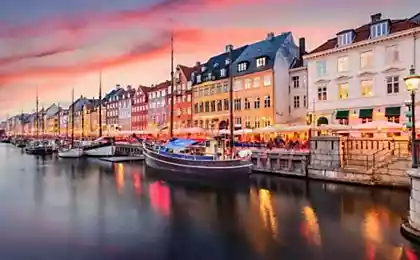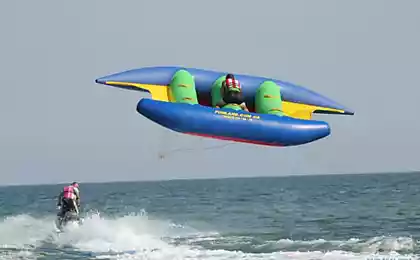528
Wind energy generating electric current for inland wind stations in Denmark
Eight million six hundred ninety thousand four hundred seventy
In the early 90-ies of the last century, Denmark established the first out shore power system using wind energy. The promise of this direction of energy development prompted the Danish energy Agency in 1997 to develop a new program on creation of the whole set of offshore wind turbines.
In ten years the Danes have reviewed the plans in the direction of adjustment of the power system, which reached 4.6 MW, which covers the internal consumption of the country. Work on the external market made it possible to start active construction of modern wind turbines with power up to 450 KW, at a distance from the coast to 2 km. the efficiency of the use of sea-based equipment exceeded 20% of the performance of wind installations. Wind rose on the sea much more steadily, and the strength and speed higher than similar features on the shore, especially in the interior of the continent.
The proximity of Copenhagen as a powerful administrative and economic metropolis, developed transport and economic infrastructure, allowed to form different forms of ownership for implementation of the full cycle of construction of marine wind turbines from design and to generate electricity. Whole water wind farms, like mushrooms, grew up along the Danish coast, providing the country is not only a cheap energy alternative, but also gave the opportunity to carry out research and development work to control the impact of such systems on the environment.
Only one wind farm Anholt, with a capacity of up to 400 MW produces up to 15% of the total energy out of all shore installations that use wind energy. The next important step in the implementation of the program of construction of offshore wind farms will design and commissioning of systems up to 600 MW. This project will allow you to combine multiple countries – Denmark, Germany and Sweden into a single energy system using marine wind farms. The current situation with the significant dependence of many countries of Western Europe on imported energy sources may change significantly at this rate of development and use of environmentally friendly, virtually inexhaustible energy of the wind.
Today, developers of wind farms are not only ways to increase capacity out of coastal systems due to a change in strategy and vision. In 2010, scientists have proposed the newest technical platform in the development of offshore wind energy. The main goal is reduction of losses in electricity transmission in the chain "sea – to-shore – consumer" and reduce the cost of production of all elements of the system. For the next decade producers have set a goal to increase the energy efficiency of installations by 25%, reduce the cost of 1 MW of energy by 40% and reduce operating costs of wind farms by half.
The Danish energy Agency for promoting the development of sea-based wind farms connected to this project and other national bodies that are interested in it. It is primarily the Ministry for spatial planning and environmental protection, Maritime Agency, and control of sea and air traffic, the Danish Ministry of Maritime security and others. They are all interested in the development of alternative sources of energy, allowing you to be politically and economically independent in today's challenging environment.
Display map of offshore wind farms
To avoid conflict of interest, Danish energy Agency has created a map of the location system of the wind farms on the coast of Northern and Baltic seas, establishing priorities, according to which will build energy in a particular place. Such cards will allow you to have not only a common visual picture of the location of the security zones when driving and navigation, marine and aircraft, but also to plan the future development of wind energy. Prepared at about 23 sites, which will be implemented by the construction of wind farms, the capacity of each shall be 200 MW.
At an average wind speed of about 10 m/s, the productivity of these plants — up to 18 terrawatt-hours per year, which will allow you to have half of Denmark's total electricity consumption. If satisfactory weather conditions, marine wind turbines can be used effectively up to 4000 hours per year. This load is optimal, both for technical support and for achievement of economic indicators of efficiency of the entire system, which uses wind energy. On average, the removal of wind farms from the shore ranges from 10-15 to 22-45 km away. this location depends on wind, the marine offshore, Maritime and air routes, as well as other factors that have ecological and environmental value.
Over time, the specialists plan to move away from fossil useful energy carrier and go to the generation of electrical energy from various alternative forms — wind parks, solar photovoltaic system and stations using tides and low tides. published
Source: zeleneet.com
In the early 90-ies of the last century, Denmark established the first out shore power system using wind energy. The promise of this direction of energy development prompted the Danish energy Agency in 1997 to develop a new program on creation of the whole set of offshore wind turbines.
In ten years the Danes have reviewed the plans in the direction of adjustment of the power system, which reached 4.6 MW, which covers the internal consumption of the country. Work on the external market made it possible to start active construction of modern wind turbines with power up to 450 KW, at a distance from the coast to 2 km. the efficiency of the use of sea-based equipment exceeded 20% of the performance of wind installations. Wind rose on the sea much more steadily, and the strength and speed higher than similar features on the shore, especially in the interior of the continent.
The proximity of Copenhagen as a powerful administrative and economic metropolis, developed transport and economic infrastructure, allowed to form different forms of ownership for implementation of the full cycle of construction of marine wind turbines from design and to generate electricity. Whole water wind farms, like mushrooms, grew up along the Danish coast, providing the country is not only a cheap energy alternative, but also gave the opportunity to carry out research and development work to control the impact of such systems on the environment.
Only one wind farm Anholt, with a capacity of up to 400 MW produces up to 15% of the total energy out of all shore installations that use wind energy. The next important step in the implementation of the program of construction of offshore wind farms will design and commissioning of systems up to 600 MW. This project will allow you to combine multiple countries – Denmark, Germany and Sweden into a single energy system using marine wind farms. The current situation with the significant dependence of many countries of Western Europe on imported energy sources may change significantly at this rate of development and use of environmentally friendly, virtually inexhaustible energy of the wind.
Today, developers of wind farms are not only ways to increase capacity out of coastal systems due to a change in strategy and vision. In 2010, scientists have proposed the newest technical platform in the development of offshore wind energy. The main goal is reduction of losses in electricity transmission in the chain "sea – to-shore – consumer" and reduce the cost of production of all elements of the system. For the next decade producers have set a goal to increase the energy efficiency of installations by 25%, reduce the cost of 1 MW of energy by 40% and reduce operating costs of wind farms by half.
The Danish energy Agency for promoting the development of sea-based wind farms connected to this project and other national bodies that are interested in it. It is primarily the Ministry for spatial planning and environmental protection, Maritime Agency, and control of sea and air traffic, the Danish Ministry of Maritime security and others. They are all interested in the development of alternative sources of energy, allowing you to be politically and economically independent in today's challenging environment.
Display map of offshore wind farms
To avoid conflict of interest, Danish energy Agency has created a map of the location system of the wind farms on the coast of Northern and Baltic seas, establishing priorities, according to which will build energy in a particular place. Such cards will allow you to have not only a common visual picture of the location of the security zones when driving and navigation, marine and aircraft, but also to plan the future development of wind energy. Prepared at about 23 sites, which will be implemented by the construction of wind farms, the capacity of each shall be 200 MW.
At an average wind speed of about 10 m/s, the productivity of these plants — up to 18 terrawatt-hours per year, which will allow you to have half of Denmark's total electricity consumption. If satisfactory weather conditions, marine wind turbines can be used effectively up to 4000 hours per year. This load is optimal, both for technical support and for achievement of economic indicators of efficiency of the entire system, which uses wind energy. On average, the removal of wind farms from the shore ranges from 10-15 to 22-45 km away. this location depends on wind, the marine offshore, Maritime and air routes, as well as other factors that have ecological and environmental value.
Over time, the specialists plan to move away from fossil useful energy carrier and go to the generation of electrical energy from various alternative forms — wind parks, solar photovoltaic system and stations using tides and low tides. published
Source: zeleneet.com
Myopathy — features of the disease and its treatment
How to install and group the stones in the rockeries





















